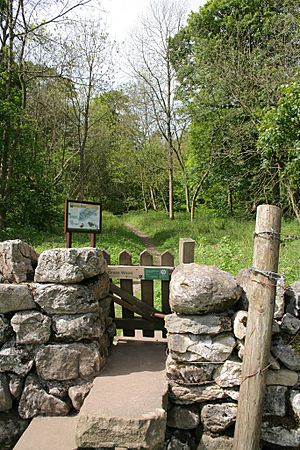Grass Wood, Wharfedale facts for kids
Grass Wood is a very old and special woodland in Wharfedale, North Yorkshire, England. It covers about 88 hectares (220 acres) (which is like 200 football fields!). This wood is famous for its amazing collection of wildflowers that grow on the ground.
Because it's so important, Grass Wood was named a Site of Special Scientific Interest (SSSI) in 1955. This means it's protected because of its unique nature. The Yorkshire Wildlife Trust bought Grass Wood in 1983. They now manage it as a nature reserve, helping to keep it safe and healthy.
Grass Wood is also the last place in Britain where the super rare Lady's Slipper Orchid naturally grows.
Contents
What is Grass Wood?
Grass Wood sits on the western and southern sides of a Carboniferous Limestone hill in Upper Wharfedale. You can find rocky areas, loose stones (scree), and flat limestone pavements all over the wood. There are also two big cliff faces.
Originally, this woodland would have been mostly European ash trees. Other trees like Wych elm and oak probably grew here too. Underneath, there would have been lots of Common hazel bushes.
How the Woodland Changed
Over the years, people cut down some trees and planted new ones. This changed the wood quite a bit. In the 1800s, beech and sycamore trees were planted on the lower slopes. Then, in the 1960s, parts of the wood were replanted with trees like Norway spruce, European larch, Scots pine, and more beech.
Today, the people managing Grass Wood are working to remove trees that aren't native to the area. They want to plant more native broadleaf trees using seeds from local plants. Many parts of the wood are now growing back naturally. You can see young ash, birch, and sycamore trees. Older trees like ash, sycamore, beech, and oak also grow here.
Shrubs and Smaller Trees
The woodland also has many different shrubs and smaller trees. These include bird cherry, hazel, spindle, buckthorn, wild privet, blackthorn, and guelder-rose.
Special Plants and Soil
The ground in Grass Wood is mostly made of limestone. This means it drains well and is perfect for plants that love lime, called calcicoles. But in some wetter spots, you can find plants that don't like lime, called calcifuges. These include bracken, common valerian, and wild angelica.
Visiting Grass Wood
There is one public footpath through Grass Wood. Since it's also registered common land, you can walk freely within its boundaries. Many other paths have been created over time by people walking through the wood.
Plants of Grass Wood
Grass Wood is a very important place for plants. It's one of the largest remaining old woodlands on limestone in the Yorkshire Dales. This is why it's protected as a Site of Special Scientific Interest (SSSI). Even though the trees have changed over time, the amazing variety of ground plants is typical of an ancient woodland on limestone. This rich plant life continues to thrive because the woodland cover has been there for a long time. Also, sheep don't graze in Grass Wood, which helps the plants grow without being eaten.
Ancient Woodland Plants
Many plants found here are signs of an old, undisturbed woodland. These include:
- Herb Paris
- Lily-of-the-valley
- Ramsons
- Wood Sorrel
- Wood Anemone
- Dog's Mercury
- Woodruff
- Wood-sedge
Geophytes: Plants with Bulbs
Grass Wood also has many geophytes. These are plants that have bulbs or similar growths underground. This helps them survive well in woodlands. Some of these are the ancient woodland plants mentioned above, like lily-of-the-valley, herb paris, and ramsons. You can also find:
- The less common angular Solomon's-seal
- Common bluebells
- Lord-and-ladies
The Lady's Slipper Orchid
The Early-purple Orchid is another geophyte found in Grass Wood. It grows in lighter, shadier spots. This shows it can live in different places, even though it's usually found in open grasslands.
Grass Wood seems like a perfect place for the very rare and endangered Lady's Slipper Orchid. This orchid used to grow naturally in the limestone areas of the Yorkshire Dales. In Europe, it grows in shady woodland areas on limestone.
The Lady's Slipper Orchid almost disappeared because people dug it up for gardens and collections. Also, its natural home shrunk as woodlands were cleared. Sheep grazing probably finished it off. People are now working to save this orchid. Hopefully, Grass Wood will be one of the places where it can be brought back to grow again.
Other Woodland and Grassland Plants
Other woodland plants you can find in Grass Wood include:
- Wild Strawberry
- Red Campion
- Wood Cranesbill
- Primrose
- Bugle
- St John's wort
- A few Columbine plants grow at the edges of the wood.
You might also spot rare clumps of Stinking iris and Stinking Hellebore. In clearings, you can find grassland plants like Lady's-mantle (Alchemilla glabra), Great Burnet, Melancholy Thistle, and Goldilocks Buttercup.
Plants on Rocky Edges
On the steep, rocky edges of the limestone, especially in sunny areas like Dewbottom Scar, you can find plants that like dry, rocky grasslands. These include:
- The locally uncommon Rock Whitebeam
- Burnet Rose
- Common Rock-rose
- Bloody Crane's-bill
- Salad-burnet
- Wild Marjoram
- Wild Thyme



